home | internet service | web design | business directory | bulletin board | advertise | events calendar | contact | weather | cams

|
China - Then and Now 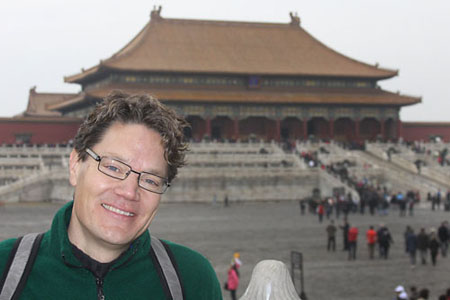 Mark Wenzel at The Forbidden City during his visit to China in early November. Mark Wenzel at The Forbidden City during his visit to China in early November.After returning from a recent visit to China, I decided to watch “The Last Emperor,” Bernardo Bertolucci’s 1989 award-winning film about the demise of Imperial China in the early 20th Century. The film’s producers somehow persuaded Chinese officials to allow them to shoot in the Forbidden City – the first foreign film to achieve such access. The result is dramatic. We see the boy emperor, Puyi, ascending the throne at the age of three in the lavish Hall of Supreme Harmony, one of 800 buildings in the city. In other scenes, we see him running across courtyards, learning to ride a bike and trying to break free from the 178-acre compound. Puyi came of age at a time when China was in chaos. Warlords controlled much of the country. Opium ran rampant. The government was in shambles. Chiang Kai Shek’s Republican forces soon took control of the capital city, leading to Puyi’s abdication in 1912. The Forbidden City – the imperial home for 500 years – earned its name both for those on the inside and out. Commoners could not enter, while the emperor and his court could not leave. Even after he abdicated, the ruling forces allowed Puyi to remain in the city with full provisions from the government. The 27-foot walls and massive steel doors served as an effective physical barrier to the outside world. Puyi stayed there until he was expelled by a warlord in 1924. As I passed through those doors in early November, I was struck by the history of the place. Just the 20th Century alone provides a breathless stretch of historical significance. The Republican revolution, the rise of the communists, Japan’s invasion, World War II, the formation of the People’s Republic of China, Mao’s rule and the Cultural Revolution, Tiananmen Square, democratic protests and free-market reforms all took place within the last 100 years.  Mark was part of an educators' tour sponsored by the Chinese government and the U.S. College Board. Mark was part of an educators' tour sponsored by the Chinese government and the U.S. College Board.Old China, new China I visited China on a whirlwind eight-day visit as part of an educators’ tour sponsored by the Chinese government and the U.S. College Board. The Chinese Ministry of Education is interested in promoting Chinese language and culture abroad, as well as learning from the west. Accordingly, they bring about 400 U.S. educators to China each fall to give American education leaders a deeper understanding of China and to promote school partnerships. The incentive for U.S. schools is practical. China’s economy now ranks second in the world. Chinese is the fastest growing foreign language in U.S. high schools. And geopolitically, China stands as a major superpower with a growing military presence and expansive arms budget. Our tour guide in Beijing mentioned the dichotomy of old China versus new. She spoke of Beijing as two cities – one preserving the country’s centuries-old heritage and the other promoting unprecedented economic growth in the form of countless skyscrapers. It’s not just buildings but people that are new. An estimated 500 million Chinese, from a population of 1.35 billion, are 25 years or younger. These are individuals for whom the struggles of the past – such as the cultural revolution of the 60s and 70s – are ancient history. Perhaps it’s the same for our own children with the Vietnam War or Watergate, but it somehow feels more potent in China. History seems so tenuous. 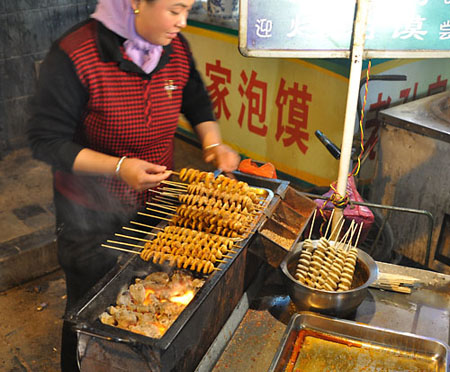 A street vendor in one of China's rapidly changing cities. A street vendor in one of China's rapidly changing cities.Rapid change Smithsonian magazine this month published a recent feature on Shanghai in which a local resident marveled at the warp speed of change in the city. Shanghai is the economic engine of China and the city is literally bursting at the seams. It now boasts 200 skyscrapers – in an area that encompassed 200 acres of farmland 20 years ago. China – particularly Shanghai but really every major city – is a money-making machine these days. With an annual GDP growth of 9 percent, the country has now produced more than a million millionaires (the US has five million). A friend of mine, a young graduate from the University of Washington, recently spent time in China on a Fulbright scholarship. A fluent Mandarin speaker, he struggled making friends his own age. “The only thing people under the age of 50 want to talk about is making money,” he told me. He eventually became an honorary member of a neighborhood senior citizens’ group and had a wonderful time talking about culture and history with local grandmothers and grandfathers. The “socialist market economy,” in place since Deng Xiaoping’s reforms in 1979, has allowed citizens to pursue unfettered economic success. Material well-being seems to be a huge motivator for the younger generation in today’s China. The country’s major cities experience 200-400 new cars on the road each day. 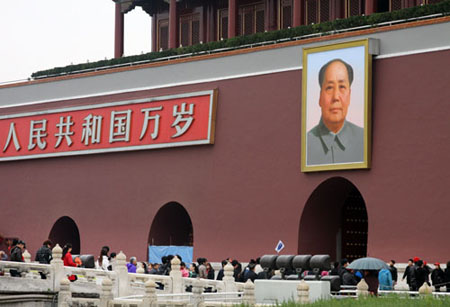 The National Museum of China in Tiananmen Square, Bejing. The National Museum of China in Tiananmen Square, Bejing.Education reform On our trip, we visited about six schools – all high-end middle and high schools in Beijing and the ancient capital of Xian. A couple things stand out. First, class sizes are huge. Most classes packed in 50 to 60 students sitting in rows. The teacher stood at the front of the classroom with a head microphone to amplify her voice. Most teaching and learning in China remains traditional. The teacher presents information. The students dutifully write down answers or call out responses in unison. This is how school learning has looked in much of the world for the last 100 years. But education research – and the reform movement in the US – is pressing for change. In particular, we know that students learn more when they do more of the work. That means exploring with their hands, developing hypotheses, experimenting, writing, collaborating with partners, making mistakes and – hopefully – achieving the periodic breakthrough. Such learning, we know from research and experience, fosters more critical thinking. As we heard from government officials, China is interested in promoting similar reforms. The challenge is a test-taking system that rewards memorization and recitation. It comes from the old days when young scholars would memorize Confucian texts and take exams to demonstrate their knowledge. Each year, the highest achievers from throughout the country would travel to the Forbidden City to compete, with the overall top scorer celebrated by the masses as he exited the city on a white horse. 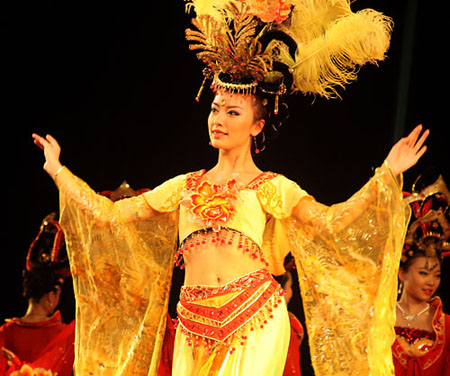 A performance of Chinese dance was part of the educators' tour. A performance of Chinese dance was part of the educators' tour.The spirit of this system remains to this day, as high school seniors compete to gain acceptance to Beijing University and other top schools. Such history and deeply embedded cultural practice make education reform more challenging. Premier Wen Jiabao recently toured schools and declared that China needs to promote more innovation and creative talents. The country needs to learn from other countries such as the United States, he said. Education professor Zhao Yong, now at the University of Oregon, notes the irony of China trying to move toward an American-style creative approach to learning, while the U.S. government promotes greater standardization and uniformity. His point: What makes this country great is the nurturing of individual talents and promotion of creativity in schools. At the same time, I was impressed by how hard Chinese students worked. It was clear that they saw the link between personal initiative and future success. They seemed determined to take advantage of the opportunities presented to them. I also came away impressed with how much the Chinese government invests in professional development for teachers. K-12 educators receive up to 15 days of training per year. School partnership 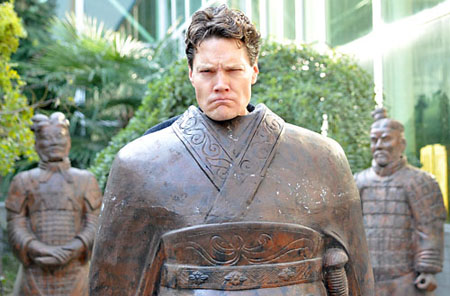 Mark Wenzel posing as a Chinese warrior. Mark Wenzel posing as a Chinese warrior.During the trip, the tour organizers arranged a partnership fair where U.S. educators could meet Chinese counterparts to discuss future alliances. We talked about cultural exchanges and how to support student learning. I came back to the valley with a couple strong possibilities. Liberty Bell has about 25 students studying Chinese. Eveline Wathen, who spent many years in Taiwan and Beijing, leads the program. When I mentioned the possibility of studying in Beijing, several students grew visibly excited. My hope is to help build bridges between students in our valley and the world. An exchange with a Beijing school would allow interested students to deepen their understanding of this 21st Century powerhouse and gain critical language skills that could prove useful in the future. If they go, I hope they visit the Forbidden City. Maybe they can learn about Puyi and realize how much China has changed, while helping the country pave a future course. 11/29/2011 |